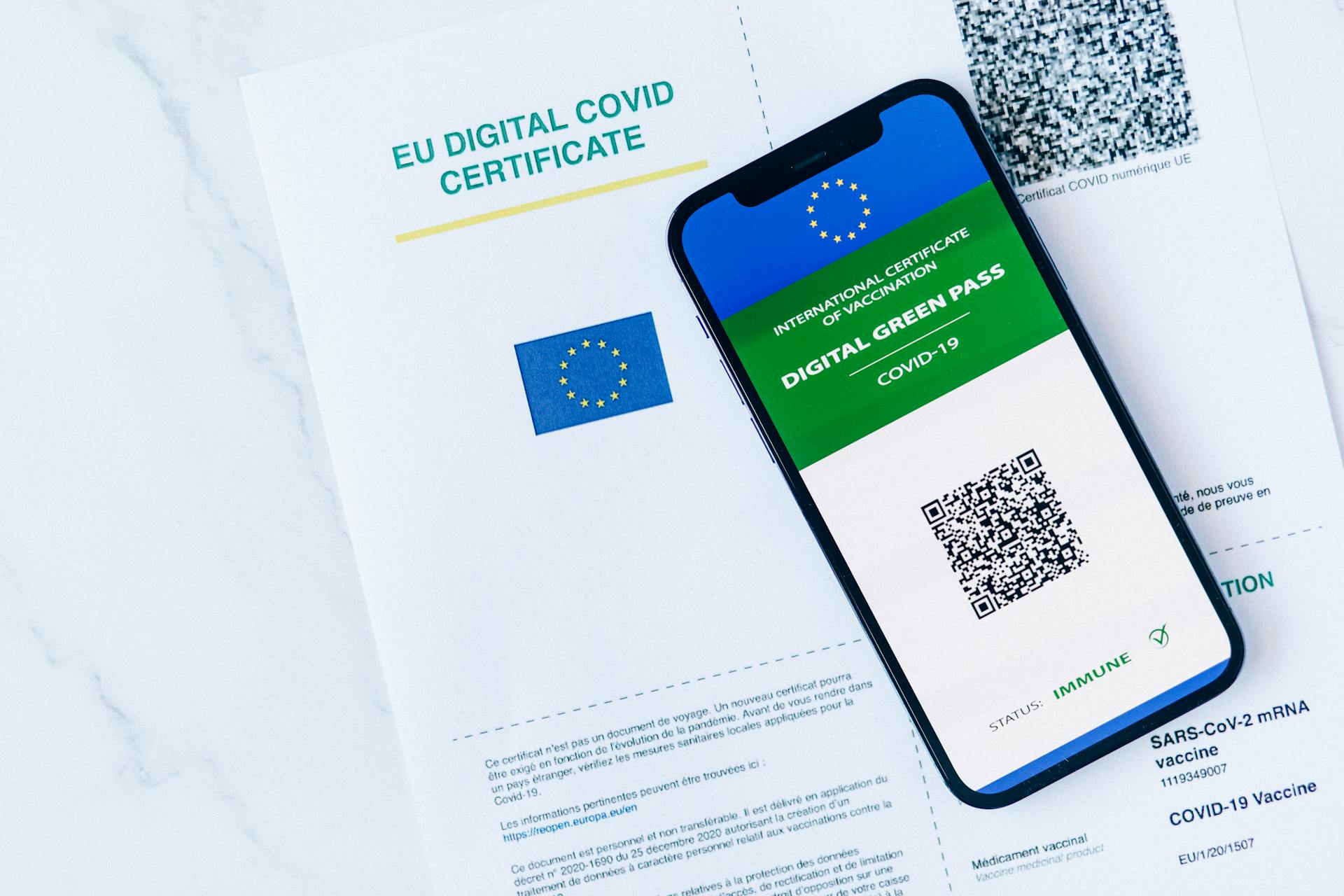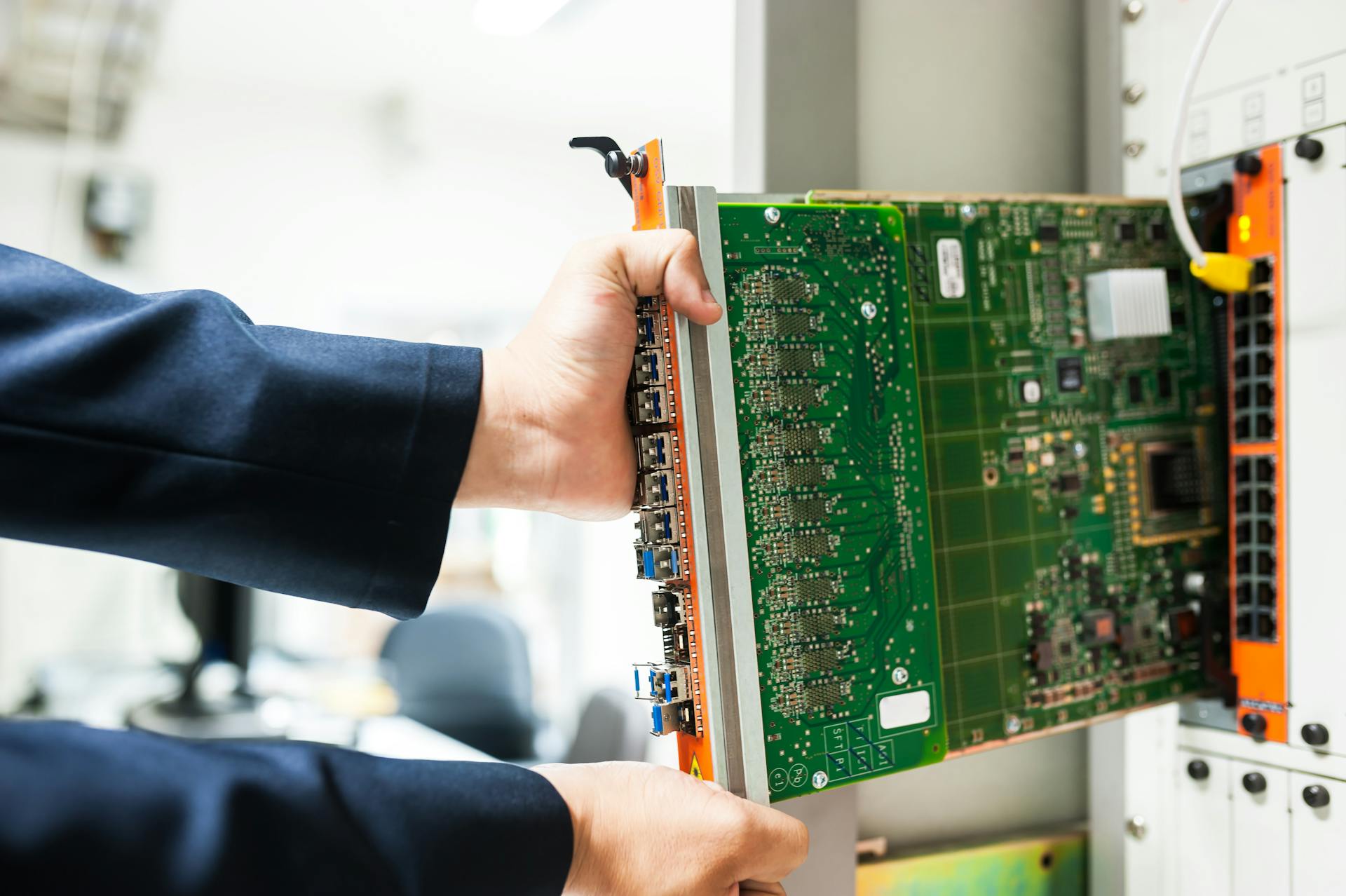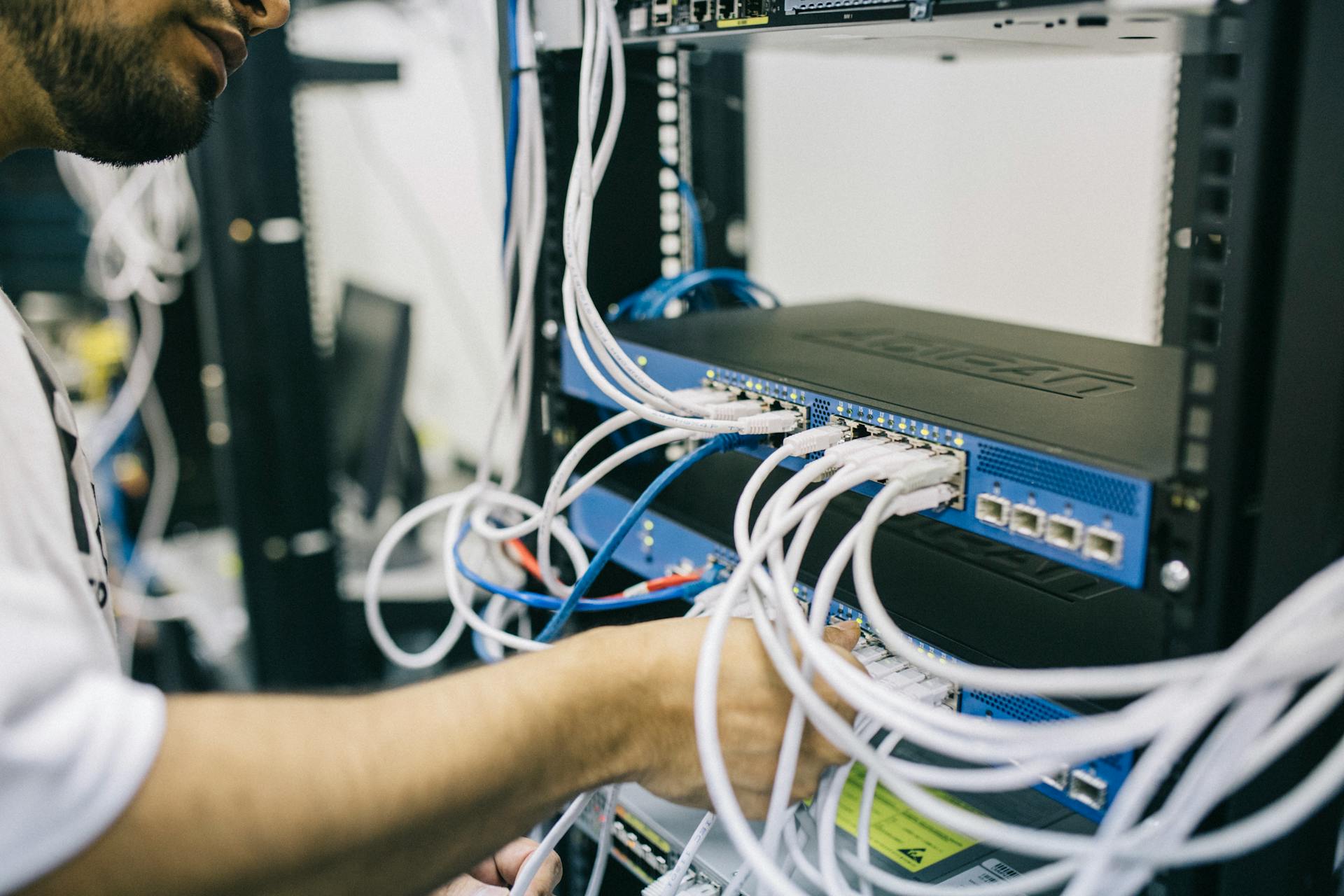
PCI compliance is a set of standards that ensures the secure handling of sensitive customer information, such as credit card numbers and personal data.
To achieve PCI compliance, merchants must follow a set of industry-standard requirements, which include implementing firewalls and access controls to protect cardholder data.
Merchants must also ensure that all cardholder data is stored securely, using encryption methods such as SSL/TLS.
Encryption is a crucial aspect of PCI compliance, as it protects sensitive data from unauthorized access.
A different take: Unrestricted Data
PCI Compliant Meaning
Being PCI compliant means an organization has met the security standards set by the Payment Card Industry Data Security Standard (PCI DSS) to ensure the secure handling of credit card information.
The PCI DSS is a set of security standards created by the Payment Card Industry Security Standards Council, which includes representatives from major credit card companies like Visa, Mastercard, and American Express.
These standards are designed to protect cardholder data and prevent security breaches. Organizations that interact with credit cards must comply with PCI DSS, which includes technical and business requirements.
A fresh viewpoint: Wage Payment Collection Act

There are 12 broad requirements and over 300 sub-requirements within PCI DSS, which are designed to meet six broad control objectives.
Here are the six control objectives:
- Build and maintain a secure network and systems
- Protect cardholder data
- Maintain a vulnerability management program
- Implement strong access control measures
- Regularly monitor and test networks
- Maintain an information security policy
Organizations that fail to comply with PCI DSS can face serious consequences, including fines from banks, increased fees, and even the severance of relationships with merchants.
Benefits and Challenges
Complying with PCI DSS means you're taking a big step towards protecting sensitive payment card information. This, in turn, helps build trust with customers.
Enhanced customer trust is one of the key benefits of PCI DSS compliance, as it ensures the security of cardholder data. This can lead to repeat business and increased customer loyalty.
Reducing the risk of data breaches is another significant advantage of PCI DSS compliance. PCI DSS' security controls and data protection procedures minimize the risk of data breaches and the associated costs, such as fines, legal fees, and reputational damage.
You might like: Cyber Risk Modeling
PCI DSS compliance also reduces the risk of financial loss connected to fraud. By preventing and detecting fraud, businesses can avoid costly penalties and maintain a positive reputation.
In addition to these benefits, PCI DSS compliance demonstrates a commitment to industry best practices. This can improve a business's standing with partners, stakeholders, and regulators.
Here are some of the key benefits of PCI compliance:
- Systems are secure, and customers can trust you with their sensitive payment card information.
- PCI Compliance improves your reputation with acquirers and payment brands.
- PCI Compliance aids in preventing security breaches and payment card data theft.
- PCI Compliance contributes to a global payment card data security solution.
- PCI Compliance likely leads to improving IT infrastructure efficiency.
Best Practices
To be PCI compliant, you should only store cardholder data that's critical to your business functions. This means being mindful of what sensitive information you're collecting and storing.
Developing a compliance program is crucial, including strategic objectives, roles, policies like strong password requirements, and procedures for completing compliance tasks. This program should be regularly reviewed and updated to ensure it remains effective.
Assigning responsibilities and roles for compliance to knowledgeable, qualified, and capable employees is essential. This includes dedicating resources to monitor and adapt compliance programs to changes in cybersecurity threats.

Regular monitoring and testing of security systems, processes, and controls can help detect and address potential vulnerabilities and threats. This should be done regularly, not just during audits.
Here are some key best practices to keep in mind:
- Only store sensitive information that's critical to your business functions.
- Develop a compliance program that includes strategic objectives, roles, policies, and procedures.
- Assign responsibilities and roles for compliance to knowledgeable employees.
- Regularly monitor and test security systems, processes, and controls.
Industry Standard Terms
The Payment Card Industry Data Security Standard (PCI DSS) is a set of security standards that governs those who process, transmit, or store credit cardholder data.
The PCI Security Standards Council, which includes representatives from major credit card companies like Visa, Mastercard, and American Express, creates and oversees the requirements within PCI DSS.
There are six broad control objectives that PCI DSS aims to meet: Build and maintain a secure network and systems, Protect cardholder data, Maintain a vulnerability management program, Implement strong access control measures, Regularly monitor and test networks, and Maintain an information security policy.
PCI DSS has 12 broad requirements and more than 300 sub-requirements.
Organizations that accept, process, store, or transmit cardholder data must comply with PCI DSS, including Penn State.
Worth a look: Card Data Covered by Pci Dss Includes

PCI DSS compliance is very important, as failure to comply could mean fines from banks, increased fees, or even severance of relationships with merchants.
The PCI Security Standards Council offers a range of tools and resources to help organizations ensure the security of cardholder information, including Self-Assessment Questionnaires to validate PCI DSS compliance.
Here are the six broad control objectives of PCI DSS:
- Build and maintain a secure network and systems
- Protect cardholder data
- Maintain a vulnerability management program
- Implement strong access control measures
- Regularly monitor and test networks
- Maintain an information security policy
Self-Assessment Questionnaire (SAQ)
The Self-Assessment Questionnaire (SAQ) is a tool that allows merchants to self-evaluate their compliance with PCI DSS standards.
There are multiple types of SAQ, each with a different length depending on the entity type and payment model used.
Each SAQ question has a yes-or-no answer, and any "no" response requires the entity to indicate its future implementation.
Your unit leadership will let you know whether your unit can use the SAQ as part of compliance with PCI DSS.
SAQ forms can be found below.
An attestation of compliance (AOC) based on the SAQ is also completed.
The SAQ is intended for small to medium sized merchants and service providers to assess their own PCI DSS compliance status.
The PCI DSS Self-Assessment Questionnaire (SAQ) is a validation tool used for this purpose.
This document contains the requirements by SAQ type.
Take a look at this: What Does No Face No Case Mean?
Prevention and Protection
To prevent skimming, review the resource guide from the PCI Security Standards Council.
You can reduce the threat of skimming by changing the password on your router, modem, and point of sale system.
Ensure that all devices and software requiring a password have a unique one, and keep a list of all devices and software that need a password or security access.
Cardholder data must be encrypted with specific algorithms, and encryption keys must also be encrypted for compliance.
Regular maintenance and scanning of primary account numbers (PAN) are necessary to ensure no unencrypted data exists.
Security Measures
To achieve PCI compliant meaning, you need to implement robust security measures. Secure coding is a must, as it involves creating and implementing applications that are resistant to tampering and compromise.
Proper password protections are also essential, including keeping a list of all devices and software that require a password, changing generic passwords, and enacting basic precautions and configurations. This will help prevent security vulnerabilities from being easily accessed by the public.
Firewalls are another crucial security measure, as they block access of foreign or unknown entities attempting to access private data. Regular maintenance and scanning of primary account numbers (PAN) are also necessary to ensure no unencrypted data exists.
Protecting Cardholder Data
Protecting Cardholder Data is crucial to prevent unauthorized access and tampering. The process of creating and implementing applications that are resistant to tampering and/or compromise is known as Secure Coding.
To protect cardholder data, it must be encrypted with certain algorithms. Regular maintenance and scanning of primary account numbers (PAN) are needed to ensure no unencrypted data exists.
Cardholder Data, or CHD, at a minimum, consists of the full PAN. Cardholder data may also appear in the form of the full PAN plus any of the following: cardholder name, expiration date and/or service code.
Cardholder Data must be encrypted with certain algorithms, and these encryptions are put into place with encryption keys. These encryption keys are also required to be encrypted for compliance.
The customer to which a payment card is issued, or any individual authorized to use the payment card, is known as a Cardholder.
You might like: Pci Compliant Payment Gateway
Firewall Use and Maintenance
Firewalls are a crucial part of any security system, and they're often the first line of defense against hackers.
Firewalls essentially block access of foreign or unknown entities attempting to access private data, making them a highly effective prevention system.
They're required for PCI DSS compliance because of their ability to prevent unauthorized access, which is a major concern for businesses that handle sensitive customer information.
Firewalls are not a one-time installation, they need to be regularly maintained to ensure they continue to function properly and protect your data.
Regular updates and patches can help fix vulnerabilities that hackers might exploit, keeping your system secure and up-to-date.
Anti-Virus Maintenance
Installing anti-virus software is a must for all devices that interact with and/or store sensitive information, such as credit card numbers.
This software should be regularly patched and updated to ensure it remains effective against the latest threats.
Access Control
Access Control is a crucial aspect of maintaining PCI compliance. Restricting data access to only those who need it is essential. This means that all staff, executives, and third parties who don't need access to cardholder data should not have it.
Having individual credentials and identification for access is also vital. This eliminates the risk of multiple employees knowing the same username and password, which can be a significant vulnerability.
Unique IDs for access create less vulnerability and make it easier to respond quickly in the event of a data breach. Regularly updating access roles is also important, as required by PCI DSS.
Physical access to cardholder data must be restricted to a secure location. This includes both physically written or typed data and digitally-kept data, such as on a hard drive. Access should be limited, and anytime sensitive data is accessed, it should be logged.
Compliance and Validation
Compliance validation involves evaluating and confirming that security controls and procedures have been implemented according to the PCI DSS. This validation occurs through an annual assessment, either by an external entity or by self-assessment.
Formal validation of PCI DSS compliance is not mandatory for all entities, but it's required for level 1 to 3 merchants and may be optional for Level 4 merchants, depending on the card brand and acquirer.
Related reading: Cyber Security Risk Assessment Report
Here's a breakdown of who needs to undergo PCI DSS validation:
- Level 1 to 3 merchants: Required to undergo PCI DSS validation
- Level 4 merchants: Optional, but may be set by the acquirer
- Issuing banks: Not required to undergo PCI DSS validation, but must secure sensitive data in a PCI DSS-compliant manner
- Acquiring banks: Must comply with PCI DSS and have their compliance validated with an audit
Meet Digital Guardian Requirements
Digital Guardian enables you to effectively discover, monitor and control PCI DSS data.
You can meet PCI compliance requirements with Digital Guardian, just like how it helps with discovering, monitoring, and controlling sensitive data.
Digital Guardian helps with PCI DSS data, and it's a great tool for ensuring compliance.
To meet digital guardian requirements, you need to effectively discover, monitor and control your sensitive data.
A different take: Digital Wallet Fraud
Validation of Compliance
Validation of compliance is a crucial aspect of the PCI DSS. It involves the evaluation and confirmation that security controls and procedures have been implemented according to the PCI DSS.
Validation occurs through an annual assessment, either by an external entity or by self-assessment. This assessment examines the compliance of merchants and service providers with the PCI DSS at a specific point in time, frequently using sampling to allow compliance to be demonstrated with representative systems and processes.

It's the responsibility of the merchant and service provider to achieve, demonstrate, and maintain compliance throughout the annual validation-and-assessment cycle across all systems and processes. A breakdown in merchant and service-provider compliance with the written standard may have been responsible for the breaches.
Compliance validation is required only for level 1 to 3 merchants and may be optional for Level 4, depending on the card brand and acquirer. According to Visa's compliance validation details for merchants, level-4 merchant compliance-validation requirements are set by the acquirer.
Here's a breakdown of the compliance-validation requirements for different merchant levels:
It's worth noting that over 80 percent of payment-card compromises between 2005 and 2007 affected level-4 merchants, who handled 32 percent of all such transactions.
Related Terms
In the world of PCI compliance, there are several key terms you should know. Cardholder data environment (CDE) is a critical concept that refers to the network and systems that store, process, or transmit cardholder data.
A cardholder data environment (CDE) is a specific area of a company's network that handles cardholder data. This could be a physical server room, a virtual private cloud, or even a mobile device.
PCI compliance is a set of standards required to ensure the secure handling of cardholder data. To achieve PCI compliance, organizations must adhere to a set of 12 key requirements, which are outlined in the PCI DSS 12 requirements.
Here are the 12 requirements:
- 1. Install and maintain a firewall configuration to protect cardholder data.
- 2. Do not use vendor-supplied defaults for system passwords and other security parameters.
- 3. Protect stored cardholder data.
- 4. Encrypt transmission of cardholder data across open, public networks.
- 5. Use and regularly update antivirus software or programs.
- 6. Develop and maintain secure systems and applications.
- 7. Restrict access to cardholder data by business need to know.
- 8. Assign a unique ID to each person with computer access.
- 9. Restrict physical access to cardholder data.
- 10. Track and monitor all access to network resources and cardholder data.
- 11. Regularly test security systems and processes.
- 12. Maintain a policy that addresses information security.
Cardholder data (CD) is any information related to a cardholder, including their name, address, phone number, and of course, their card number.
Frequently Asked Questions
What does it mean to not be PCI compliant?
Not being PCI compliant means your business is vulnerable to increased exposure to fraud and data breaches due to inadequate payment security measures. This can put sensitive customer information at risk, making it essential to learn more about the importance of PCI compliance and how to achieve it.
Sources
- https://www.pcisecuritystandards.org/glossary/
- https://en.wikipedia.org/wiki/Payment_Card_Industry_Data_Security_Standard
- https://www.techtarget.com/searchsecurity/definition/PCI-DSS-Payment-Card-Industry-Data-Security-Standard
- https://security.psu.edu/privacy/pci-dss/
- https://www.digitalguardian.com/blog/what-pci-compliance
Featured Images: pexels.com


